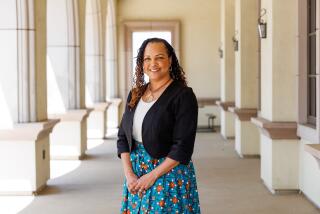Indochinese Conference : Schools Let Refugees Down, Educators Told
Despite the academic success of Southeast Asian refugee students, for every valedictorian “many are falling through the cracks,” a San Diego State University researcher said Friday.
Too many educators have taken Southeast Asian students’ work ethic and discipline for granted. But, warns researcher Kenji Ima, who recently completed a study on Southeast Asian students, “they will not make it into the mainstream of society without assistance.”
Ima spoke to an audience of about 400 predominantly Southeast Asian educators attending the Ninth Annual Conference on Indochinese Education and Social Services at the Anaheim Hilton. The conference ends today.
‘A Red Flag’
To counter the way some people perceive Southeast Asian students, Ima said that many have high grade-point averages but don’t do well in state tests for reading, language expression, comprehension and vocabulary.
“This is a red flag for those in education whose purpose is to help them move into different careers. . . . You have to see where their motivations lie,” Ima said, adding that Southeast Asian students view English courses less favorably because they are difficult and can lower their grade-point averages.
The $38,000 study was paid for by the federal Office of Refugee Resettlement to find out whether the second generation of Southeast Asians, almost all of whom are children of poverty, is likely to become economically self-sufficient through success in school and not require continued public welfare.
Ima and co-researcher Ruben G. Rumbaut, who is also an associate professor of sociology at San Diego State University, took 18 months to complete the study that focused on Indochinese students among 24,660 juniors and seniors in San Diego area schools.
Ima was invited to speak because the study may give way to new programs, said Khamchong Luangpraseut, Indochinese program supervisor at Santa Ana Unified School District who helped plan this year’s conference.
“I am Lao, and we in the Laotian community have been asking ourselves why Lao students consistently score so low in school tests,” Luangpraseut said.
One answer, Ima said, might be that teacher expectations for Lao and Khmer students “remain very low.”
Lump Groups Together
Part of the problem, he said, is that school officials and the public tend to lump Southeast Asian students into one group and fail to differentiate among the main groups, such as Vietnamese, Khmer, who are from Cambodia, Laotian and Chinese.
Acceptance of such a broad picture creates little understanding of the refugee experience, especially when dealing with trauma-plagued Khmer students and their families, Ima said.
As an example, Ima told the audience of an interview with a Khmer student he referred to as “Sophie.”
“Sophie is a Khmer female. She got all Fs. But she’s bright. Very alert, and not dumb. Her English is so-so but understandable. Two things bother Sophie: her mother and Sophie’s own life,” Ima said.
Sophie’s mother was widowed during the Khmer Rouge regime of the dictator Pol Pot, Ima said. Consequently, her mother is suffering from post-traumatic stress and has offered little help as a parent to Sophie.
Post-Traumatic Stress
“As for Sophie, she told me about her starvation, the deaths she saw, and she told me about her nightmares. She herself has post-traumatic stress. Who can give a heck about school when you’re so depressed?”
Ima believes that the consequences of the Pol Pot regime show up in the dropout rate for Khmer refugee students, which is highest among Indochinese students.
“It isn’t just culture. It shows up in the refugee experience, and we are dealing with a very diverse group when we’re talking about Southeast Asian refugee students.”
In Orange County, Indochinese refugee students make up almost 11% of the 342,131 students enrolled in kindergarten through 12th grade.
Santa Ana Unified, which is Orange County’s largest school district with 38,197 students, has about 200 Hmong, 200 Laotian, 800 Cambodian and about 2,000 Vietnamese refugee students, Luangpraseut said.
More to Read
Sign up for Essential California
The most important California stories and recommendations in your inbox every morning.
You may occasionally receive promotional content from the Los Angeles Times.










